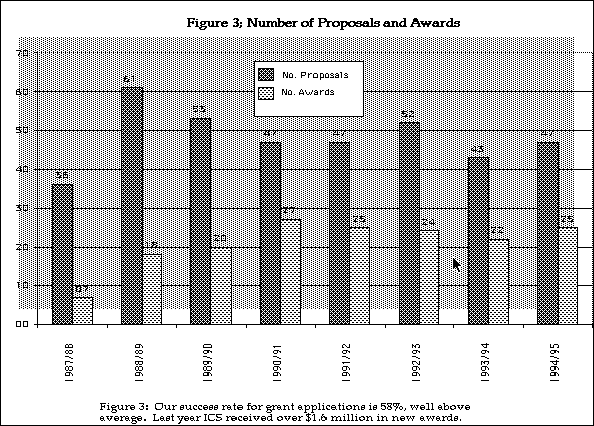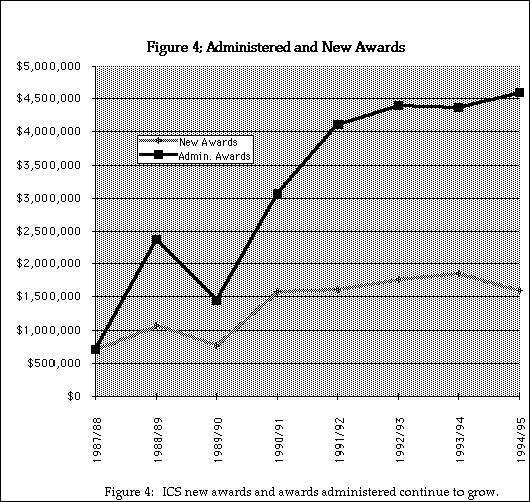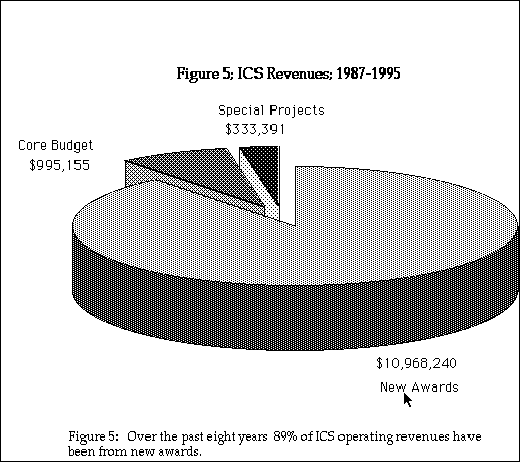 ICS
undergraduate and graduate students
ICS
undergraduate and graduate students
At present the research agenda of the ICS comprises the study of crustal structure and tectonics, how the crust is put together and deformed; crustal materials, what the crust is made of and what are its physical properties; earthquakes, how, when and where they occur in the crust and how strong they are; and, hazardous waste disposal, how industrial and nuclear materials can be safely disposed of in the crust.
This past year ICS researchers worked on 36 projects all over the world, from Alaska to Antarctica. We now count 30 in our scientific staff, which represents a steady increase. But student membership has exploded (Fig. 1). We were awarded 25 grants this year against previous submissions of 43 requests; this amounts to a success rate of 58%. New awards amounted to $1.6 million this year. During 1994/95 our scientists submitted or published 39 scientific papers. ICS researchers presented papers at the annual meetings of the American Geophysical Union, the Geological Society of America, and the Seismological Society of America.
 ICS
undergraduate and graduate students
ICS
undergraduate and graduate students
Undergraduate research activity last year at ICS included four internships sponsored by the Southern California Earthquake Center awarded to Windy Brimer, Andrew Byers, Jason McKenna, and Mike Watkins. ICS undergraduates also participated in the Los Angeles Regional Seismic Experiment (LARSE) in the Fall. The ICS seismic instrument center provided several of the portable seismographs used in the experiment and our students worked in deploying and retrieving these over the course of several weeks.
Prof. Art Sylvester continues a unique project funded by the Research Experiences for Undergraduates program of NSF. His research involves high-precision leveling across major faults in the Grand Teton range of Wyoming to determine the rate of uplift of these mountains. The project has run for five summers. About ten undergraduates accompany him on two week trips to the study area. Students are involved in the design and execution of the survey, processing of data, and interpretation of the results. Precision of a few millimeters over a 17 mile baseline has been achieved. For his continued dedication to undergraduate research experience Professor Sylvester was awarded the UC Presidential Award for Excellence in Undergraduate Research for the UCSB campus.
 Research
highlights
Research
highlights
Under research activities, ICS scientists continue to analyze ground motion data from aftershocks of the January 17, 1994 Northridge earthquake. The purpose of this is to gather fundamental data on how ground motion in specific regions responds to earthquakes; these are parameters crucial to seismic safety design. Along with this, ICS researchers continue to study ways to estimate ground motions in a variety of situations given actual field data on ground response.
ICS researchers Ralph Archuleta and Scott Swain completed drilling a 520 meter hole into crystalline rock in Garner Valley, near Hemet, CA. The hole was instrumented with seismometers and water pressure sensors. This project is aimed at studying the relation between seismic activity and ground water movements. The main question is the ultimate safety of underground nuclear waste disposal sites in seismic regions.
A new effort this past year has been direct investigation of the seismic hazard in the Santa Barbara Channel. This includes a study on the offshore extension of the Oak Ridge fault, the system believed responsible for the Northridge quake. In parallel with this has been a study of the overall deformation in the Channel. Using a unique numerical scheme, researchers have unraveled the mapped deformation of the subsurface rocks beneath the Channel waters. In doing so they have determined a direct estimate of the closure between the islands and the mainland. In partnership with Lawrence Livermore National Laboratory, ICS researchers completed a draft seismic hazard analysis of the Santa Barbara Channel for the U.S. Mineral Management Service. This study will be used by the MMS for the process of relicensing offshore oil platforms in the channel.
In parallel with these activities, ICS hosted a workshop on detachment faulting in the western Transverse Ranges sponsored by the Southern California Earthquake Center. At this workshop faulting models for the region were presented and reviewed. The workshop pointed out the lack of critical data on seismically active faults. It also stressed that a variety of different fault models need to be considered in evaluating the seismic hazard for the Santa Barbara-Ventura coastal regions.
Researchers from the ICS Vadose Monitoring Lab in collaboration with a team at Lawrence Livermore Laboratory, issued an important report reviewing California's protocol for cleaning up leaking underground fuel tanks (LUFT). The research concludes that hydrocarbons leaking from tanks have had virtually no effect on the groundwater quality of California. This important finding will be part of a major change in California's future handling of this environmental issue. In particular, rather than massive soil removal programs which have been ordered in the past, the report recommends passive bioremediation tactics.
 Meeting
the needs of the public
Meeting
the needs of the public
Research on earthquakes concerns both earthquake prediction and estimating ground motion from earthquakes. Expected strong ground motion is being studied at several locations in California, in a project sponsored by the Nuclear Regulatory Commission and the USGS. ICS continues it's active participation in the Southern California Earthquake Center (SCEC), a National Science Foundation Science and Technology Center. ICS is a major partner along with 6 other universities, and the U.S. Geological Survey. This project includes studies by ICS in the areas of regional seismicity, subsurface imaging of earthquake zones, fault zone geology, seismic hazards analysis, and geologic (tectonic) history. Some details of our research through the center are described below in the Research Section.
The movement of hydrocarbons and other hazardous materials in soils and sediments is studied in our Vadose Zone Monitoring Lab. This project is attempting to define controlling parameters on the migration of liquid and gas hydrocarbons in the crustal layer above the water table (vadose zone). This is applicable to the mitigation of the problems from leaking hazardous waste landfills and underground hazardous liquid storage tanks.
 Present,
Past, and Future
Present,
Past, and Future
Our award success rate of 58% is well above the national averages of 25% to 35% in Earth Sciences. We continue to show overall growth in the dollar amount of new awards received and awards administered (Figure 4). After the dramatic growth in our first four years, the rate has leveled to about 10% per year.
ICS operates on both internal and extramural revenues. UCSB funds include core operating budget, and special project awards. The cumulative revenues of ICS for the past 8 years are $12.3 million (Figure 5). New awards to UCSB from extramural agencies comprise $11 million or 89% of total revenues.
